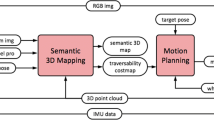Abstract
Urban roads are one of the most complicated applications in autonomous driving. The main bottleneck lies in perception and decision-making algorithms. In this work, we propose a new learning-based autonomous driving system, including a novel Convolutional Neural Network (CNN)-based multi-sensor fusion object detector, and a novel Deep Reinforcement Learning (DRL)-based decision planner. Multi-sensor fusion object detector integrates two advanced CNN-based object detectors to separately detect objects from camera image and LiDAR point cloud with high precision and processing speed. Meanwhile, a stereo vision integrated Camera-LiDAR object fusion method is proposed to complementarily fuse two sensor detections. Besides, a DRL-based decision planner is proposed by integrating DRL-based tactical long-term decision-making and spatiotemporal short-term trajectory planning in dynamic urban driving scenarios with efficiency, safety and comfort. Finally, we train the algorithms and do joint testing in real scenarios. The experimental results show that the proposed system could meet the requirements of autonomous driving in urban scene.




Similar content being viewed by others

Explore related subjects
Discover the latest articles, news and stories from top researchers in related subjects.References
Sorin G, Trasnea B, Cocias T, Macesanu G (2020) A survey of deep learning techniques for autonomous driving. J Field Robot 37(3):362–386
Kato S, Tokunaga S, Maruyama Y, Maeda S, Hirabayashi M, Kitsukawa Y et al (2018) Autoware on board: enabling autonomous vehicles with embedded systems. In: ACM/IEEE international conference on cyber-physical systems (ICCPS), pp 287–296
Levinson J, Askeland J, Becker J, Dolson J, Held D, Kammel S, Zico Kolter J et al (2011) Towards fully autonomous driving: systems and algorithms. In: IEEE intelligent vehicles symposium (IV), pp 163–168
Shaoqing R, He K, Girshick R, Sun J (2015) Faster R-CNN: towards real-time object detection with region proposal networks. Neural Inf Process Syst 28:91–99
Sallab Ahmad EL, Abdou M, Perot E, Yogamani S (2017) Deep reinforcement learning framework for autonomous driving. Electron Imaging 19:70–76
Sindagi VA, Zhou Y, Tuzel O (2019) MVX-Net: multimodal VoxelNet for 3D object detection. In: EEE inter conf robot autom (ICRA), pp 7276–7282
Liu W, Anguelov D, Erhan D, Szegedy C, Reed S, Fu C-Y, Berg AC (2016) SSD: single shot multibox detector. In: European conf. computer vision (ECCV), pp 21–37
Yutian W, Wang Y, Zhang S, Ogai H (2020) Deep 3D object detection networks using LiDAR data: a review. IEEE Sens J 21(2):152–1171
Farhadi A, Redmon J (2018) YOLOV3: an incremental improvement. arXiv:1804.02767
Redmon J, Farhadi A (2017) YOLO9000: better, faster, stronger. In: IEEE conference on computer vision and pattern recognition (CVPR), pp 7263–7271
Lang AH, Vora S, Caesar H, Zhou L, Yang J, Beijbom O (2019) Pointpillars: fast encoders for object detection from point clouds. In: IEEE conference on computer vision and pattern recognition (CVPR), pp 12697–12705
Molina E, Lazaro O, Sepulcre M, Gozalvez J, Passarella A, Raptis TP, Ude A et al (2017) The AUTOWARE framework and requirements for the cognitive digital automation. In: Working conference on virtual enterprises, pp 107–117
Yutian W, Tang S, Zhang S, Ogai H (2019) An enhanced feature pyramid object detection network for autonomous driving. Appl Sci 9(20):4363
Yutian W, Zhang S, Ogai H, Inujima H, Tateno S (2021) Realtime single-shot refinement neural network with adaptive receptive field for 3D object detection from LiDAR point cloud. IEEE Sens J 21(21):24505–24519
Ravi KB, Sobh I, Talpaert V, Mannion P, Al AA, Sallab SY, Pérez P (2022) Deep reinforcement learning for autonomous driving: a survey. IEEE Trans Intell Transp Syst 23(6):4909–4926
Zhang S , Wu Y, Ogai H (2020) Spatial attention for autonomous decision-making in highway scene. In: Annual conference of the society of instrument and control engineers of Japan (SICE), pp 1435–1440
Claussmann L, Revilloud M, Gruyer D, Glaser S (2019) A review of motion planning for highway autonomous driving. IEEE Trans on Intell Transp Syst 21(5):1826–1848
Zhang S, Yutian W, Ogai H, Inujima H, Tateno S (2021) Tactical decision-making for autonomous driving using dueling double deep Q network with double attention. IEEE Access 9:151983–151992
Ziegler J, Stiller C (2009) Spatiotemporal state lattices for fast trajectory planning in dynamic on-road driving scenarios. In: IEEE/RSJ international conference intell robots and syst (IROS), pp 1879–1884
Takahashi A, Hongo T, Ninomiya Y, Sugimoto G (1989) Local path planning and motion control for AGV in positioning. In: International workshop on intelligent robots and systems
Leurent E (2018) An environment for autonomous driving decision-making. [Online]. Available: https://github.com/eleurent/highway-env
Kesting A, Treiber M (2010) Enhanced intelligent driver model to access the impact of driving strategies on traffic capacity. Philos Trans Roy Soc A Math Phys Eng Sci 368(1928):4585–4605
Kesting A, Treiber M, Helbing D (1999) (2017) General lane-changing model MOBIL for car-following models. Transp Res Rec 1:86–94
Chang W, Zhao X, Rui F, Li Z (2020) Research on the comfort of vehicle passengers considering the vehicle motion state and passenger physiological characteristics: improving the passenger comfort of autonomous vehicles. Int J Environ Res Public Health 17(18):6821
Acknowledgements
This work was supported by JST SPRING, Grant number JPMJSP2128.
Author information
Authors and Affiliations
Corresponding authors
Additional information
Publisher's Note
Springer Nature remains neutral with regard to jurisdictional claims in published maps and institutional affiliations.
This work was presented in part at the joint symposium of the 27th International Symposium on Artificial Life and Robotics, the 7th International Symposium on BioComplexity, and the 5thInternational Symposium on Swarm Behavior and BioInspiredRobotics (Online, January 25–27, 2022).
About this article
Cite this article
Zhang, S., Wu, Y., Wang, Y. et al. Learning-based algorithms with application to urban scene autonomous driving. Artif Life Robotics 28, 244–252 (2023). https://doi.org/10.1007/s10015-022-00813-3
Received:
Accepted:
Published:
Issue Date:
DOI: https://doi.org/10.1007/s10015-022-00813-3



